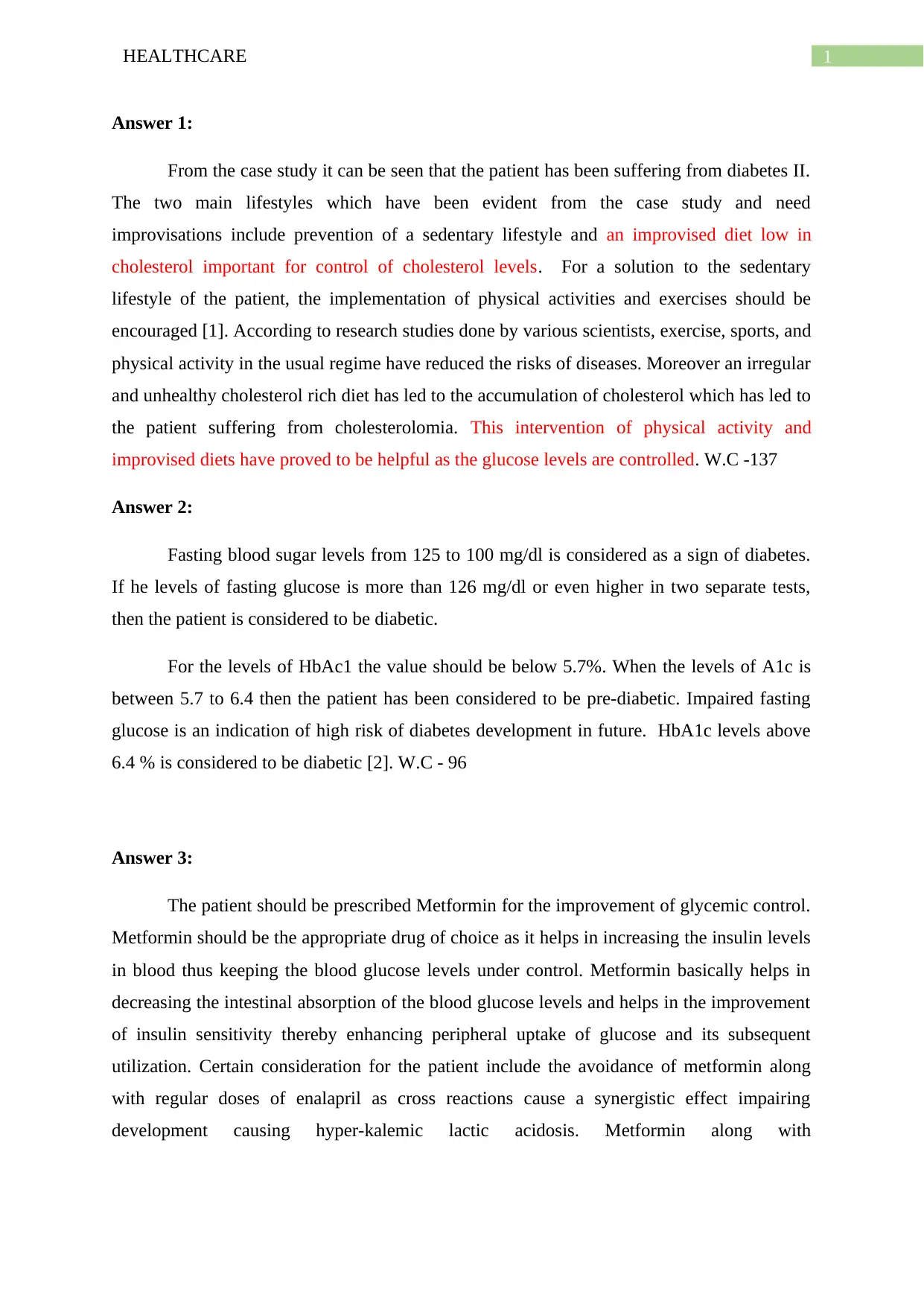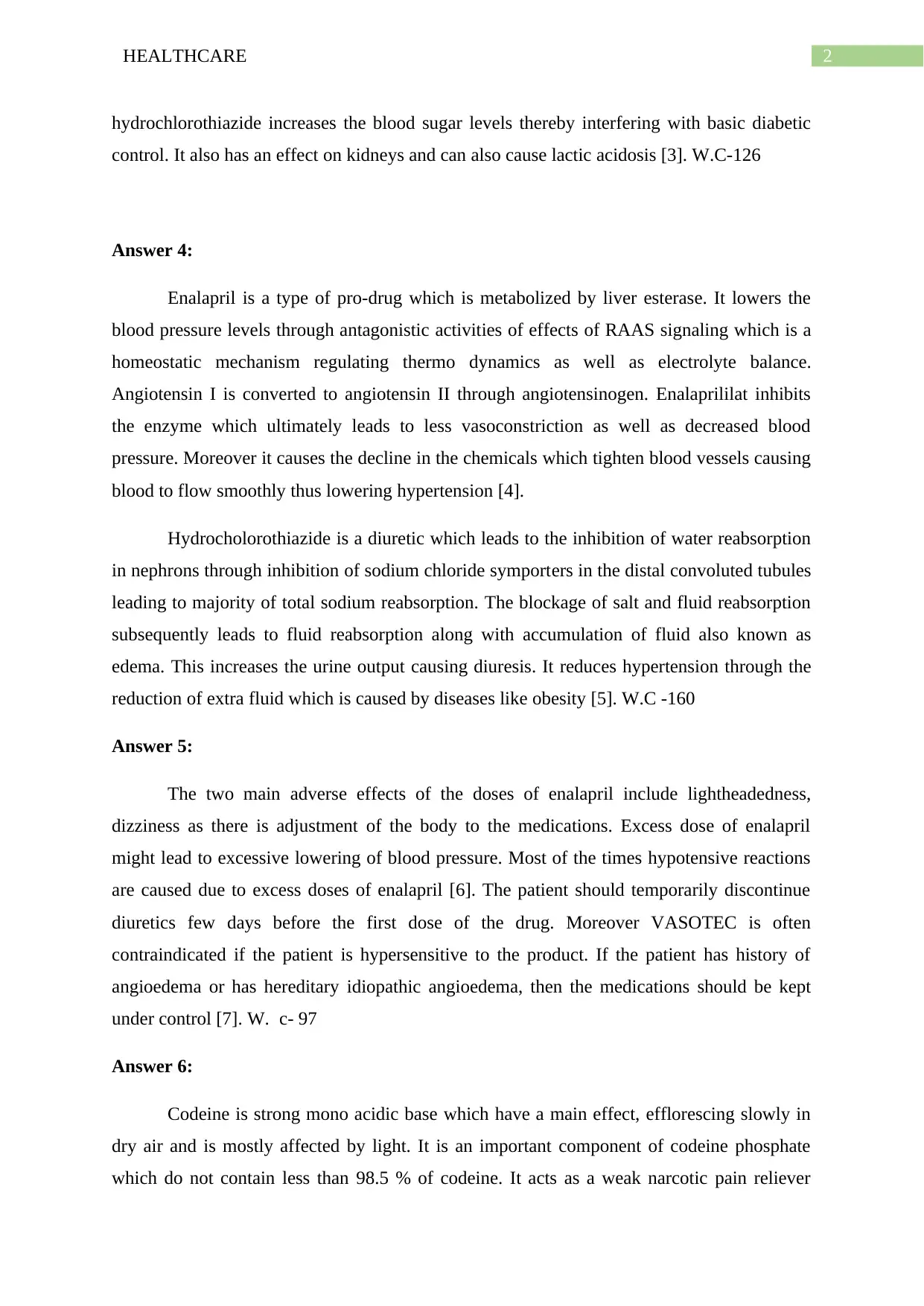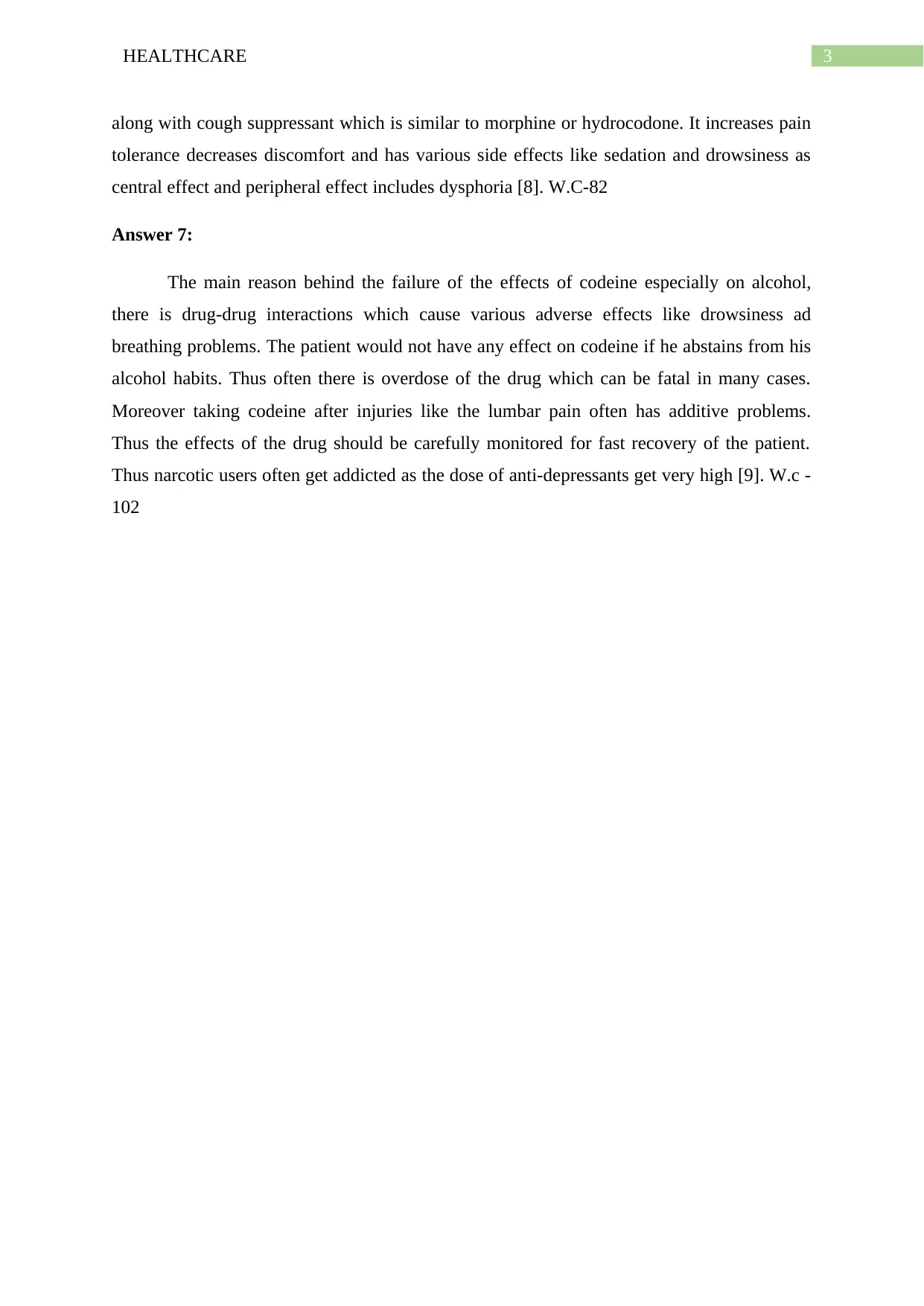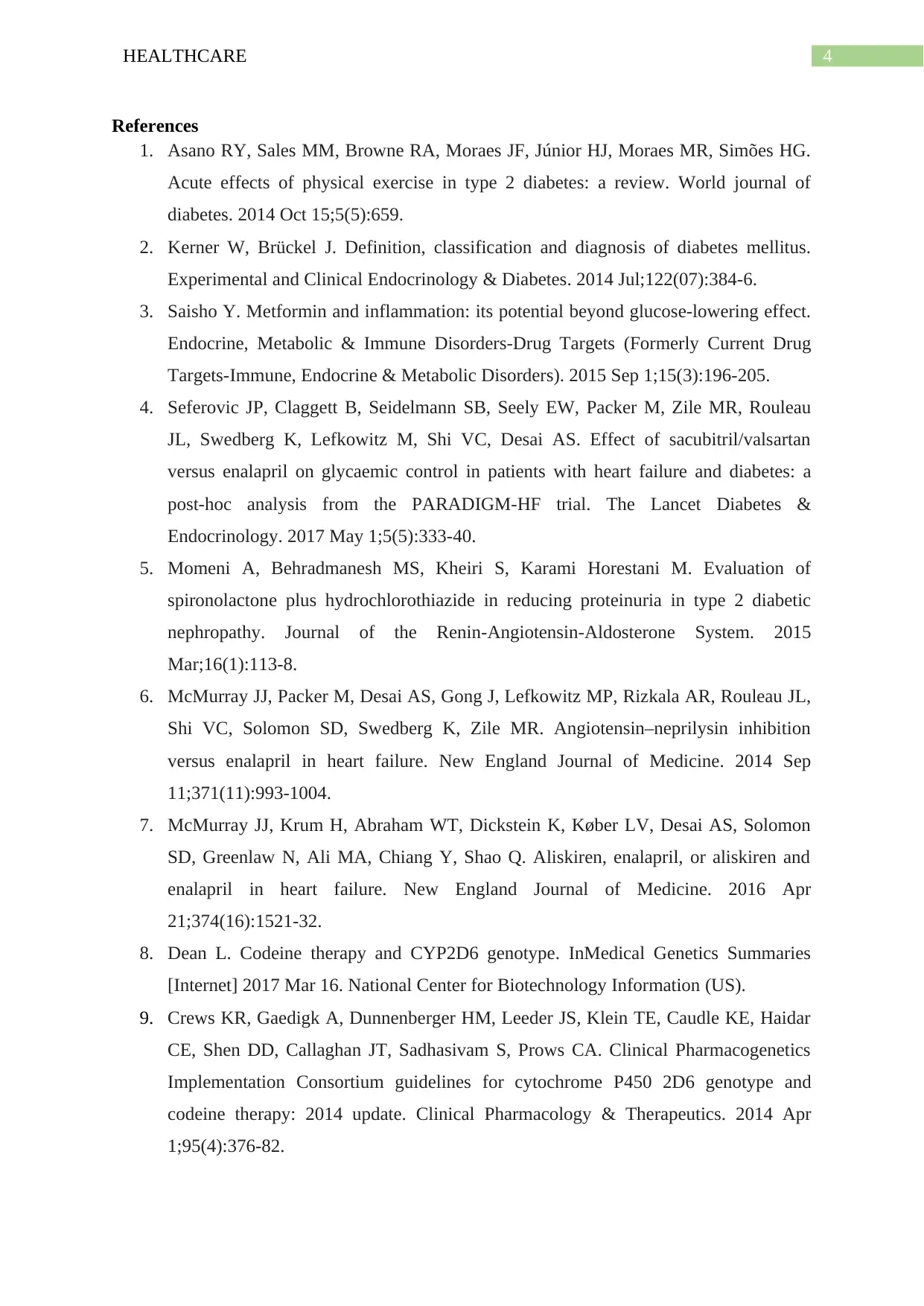Healthcare: Diabetes II and Treatment Options
VerifiedAdded on 2023/03/21
|5
|1405
|55
AI Summary
This document discusses diabetes II and various treatment options including physical activity, diet, and medication. It explores the effects and considerations of metformin and enalapril, as well as the role of codeine and its interactions. References are provided for further reading.
Contribute Materials
Your contribution can guide someone’s learning journey. Share your
documents today.

Running head: HEALTHCARE
Topic: HEALTHCARE
Name of the Student:
Name of the University:
Author Note:
Topic: HEALTHCARE
Name of the Student:
Name of the University:
Author Note:
Secure Best Marks with AI Grader
Need help grading? Try our AI Grader for instant feedback on your assignments.

1HEALTHCARE
Answer 1:
From the case study it can be seen that the patient has been suffering from diabetes II.
The two main lifestyles which have been evident from the case study and need
improvisations include prevention of a sedentary lifestyle and an improvised diet low in
cholesterol important for control of cholesterol levels. For a solution to the sedentary
lifestyle of the patient, the implementation of physical activities and exercises should be
encouraged [1]. According to research studies done by various scientists, exercise, sports, and
physical activity in the usual regime have reduced the risks of diseases. Moreover an irregular
and unhealthy cholesterol rich diet has led to the accumulation of cholesterol which has led to
the patient suffering from cholesterolomia. This intervention of physical activity and
improvised diets have proved to be helpful as the glucose levels are controlled. W.C -137
Answer 2:
Fasting blood sugar levels from 125 to 100 mg/dl is considered as a sign of diabetes.
If he levels of fasting glucose is more than 126 mg/dl or even higher in two separate tests,
then the patient is considered to be diabetic.
For the levels of HbAc1 the value should be below 5.7%. When the levels of A1c is
between 5.7 to 6.4 then the patient has been considered to be pre-diabetic. Impaired fasting
glucose is an indication of high risk of diabetes development in future. HbA1c levels above
6.4 % is considered to be diabetic [2]. W.C - 96
Answer 3:
The patient should be prescribed Metformin for the improvement of glycemic control.
Metformin should be the appropriate drug of choice as it helps in increasing the insulin levels
in blood thus keeping the blood glucose levels under control. Metformin basically helps in
decreasing the intestinal absorption of the blood glucose levels and helps in the improvement
of insulin sensitivity thereby enhancing peripheral uptake of glucose and its subsequent
utilization. Certain consideration for the patient include the avoidance of metformin along
with regular doses of enalapril as cross reactions cause a synergistic effect impairing
development causing hyper-kalemic lactic acidosis. Metformin along with
Answer 1:
From the case study it can be seen that the patient has been suffering from diabetes II.
The two main lifestyles which have been evident from the case study and need
improvisations include prevention of a sedentary lifestyle and an improvised diet low in
cholesterol important for control of cholesterol levels. For a solution to the sedentary
lifestyle of the patient, the implementation of physical activities and exercises should be
encouraged [1]. According to research studies done by various scientists, exercise, sports, and
physical activity in the usual regime have reduced the risks of diseases. Moreover an irregular
and unhealthy cholesterol rich diet has led to the accumulation of cholesterol which has led to
the patient suffering from cholesterolomia. This intervention of physical activity and
improvised diets have proved to be helpful as the glucose levels are controlled. W.C -137
Answer 2:
Fasting blood sugar levels from 125 to 100 mg/dl is considered as a sign of diabetes.
If he levels of fasting glucose is more than 126 mg/dl or even higher in two separate tests,
then the patient is considered to be diabetic.
For the levels of HbAc1 the value should be below 5.7%. When the levels of A1c is
between 5.7 to 6.4 then the patient has been considered to be pre-diabetic. Impaired fasting
glucose is an indication of high risk of diabetes development in future. HbA1c levels above
6.4 % is considered to be diabetic [2]. W.C - 96
Answer 3:
The patient should be prescribed Metformin for the improvement of glycemic control.
Metformin should be the appropriate drug of choice as it helps in increasing the insulin levels
in blood thus keeping the blood glucose levels under control. Metformin basically helps in
decreasing the intestinal absorption of the blood glucose levels and helps in the improvement
of insulin sensitivity thereby enhancing peripheral uptake of glucose and its subsequent
utilization. Certain consideration for the patient include the avoidance of metformin along
with regular doses of enalapril as cross reactions cause a synergistic effect impairing
development causing hyper-kalemic lactic acidosis. Metformin along with

2HEALTHCARE
hydrochlorothiazide increases the blood sugar levels thereby interfering with basic diabetic
control. It also has an effect on kidneys and can also cause lactic acidosis [3]. W.C-126
Answer 4:
Enalapril is a type of pro-drug which is metabolized by liver esterase. It lowers the
blood pressure levels through antagonistic activities of effects of RAAS signaling which is a
homeostatic mechanism regulating thermo dynamics as well as electrolyte balance.
Angiotensin I is converted to angiotensin II through angiotensinogen. Enalaprililat inhibits
the enzyme which ultimately leads to less vasoconstriction as well as decreased blood
pressure. Moreover it causes the decline in the chemicals which tighten blood vessels causing
blood to flow smoothly thus lowering hypertension [4].
Hydrocholorothiazide is a diuretic which leads to the inhibition of water reabsorption
in nephrons through inhibition of sodium chloride symporters in the distal convoluted tubules
leading to majority of total sodium reabsorption. The blockage of salt and fluid reabsorption
subsequently leads to fluid reabsorption along with accumulation of fluid also known as
edema. This increases the urine output causing diuresis. It reduces hypertension through the
reduction of extra fluid which is caused by diseases like obesity [5]. W.C -160
Answer 5:
The two main adverse effects of the doses of enalapril include lightheadedness,
dizziness as there is adjustment of the body to the medications. Excess dose of enalapril
might lead to excessive lowering of blood pressure. Most of the times hypotensive reactions
are caused due to excess doses of enalapril [6]. The patient should temporarily discontinue
diuretics few days before the first dose of the drug. Moreover VASOTEC is often
contraindicated if the patient is hypersensitive to the product. If the patient has history of
angioedema or has hereditary idiopathic angioedema, then the medications should be kept
under control [7]. W. c- 97
Answer 6:
Codeine is strong mono acidic base which have a main effect, efflorescing slowly in
dry air and is mostly affected by light. It is an important component of codeine phosphate
which do not contain less than 98.5 % of codeine. It acts as a weak narcotic pain reliever
hydrochlorothiazide increases the blood sugar levels thereby interfering with basic diabetic
control. It also has an effect on kidneys and can also cause lactic acidosis [3]. W.C-126
Answer 4:
Enalapril is a type of pro-drug which is metabolized by liver esterase. It lowers the
blood pressure levels through antagonistic activities of effects of RAAS signaling which is a
homeostatic mechanism regulating thermo dynamics as well as electrolyte balance.
Angiotensin I is converted to angiotensin II through angiotensinogen. Enalaprililat inhibits
the enzyme which ultimately leads to less vasoconstriction as well as decreased blood
pressure. Moreover it causes the decline in the chemicals which tighten blood vessels causing
blood to flow smoothly thus lowering hypertension [4].
Hydrocholorothiazide is a diuretic which leads to the inhibition of water reabsorption
in nephrons through inhibition of sodium chloride symporters in the distal convoluted tubules
leading to majority of total sodium reabsorption. The blockage of salt and fluid reabsorption
subsequently leads to fluid reabsorption along with accumulation of fluid also known as
edema. This increases the urine output causing diuresis. It reduces hypertension through the
reduction of extra fluid which is caused by diseases like obesity [5]. W.C -160
Answer 5:
The two main adverse effects of the doses of enalapril include lightheadedness,
dizziness as there is adjustment of the body to the medications. Excess dose of enalapril
might lead to excessive lowering of blood pressure. Most of the times hypotensive reactions
are caused due to excess doses of enalapril [6]. The patient should temporarily discontinue
diuretics few days before the first dose of the drug. Moreover VASOTEC is often
contraindicated if the patient is hypersensitive to the product. If the patient has history of
angioedema or has hereditary idiopathic angioedema, then the medications should be kept
under control [7]. W. c- 97
Answer 6:
Codeine is strong mono acidic base which have a main effect, efflorescing slowly in
dry air and is mostly affected by light. It is an important component of codeine phosphate
which do not contain less than 98.5 % of codeine. It acts as a weak narcotic pain reliever

3HEALTHCARE
along with cough suppressant which is similar to morphine or hydrocodone. It increases pain
tolerance decreases discomfort and has various side effects like sedation and drowsiness as
central effect and peripheral effect includes dysphoria [8]. W.C-82
Answer 7:
The main reason behind the failure of the effects of codeine especially on alcohol,
there is drug-drug interactions which cause various adverse effects like drowsiness ad
breathing problems. The patient would not have any effect on codeine if he abstains from his
alcohol habits. Thus often there is overdose of the drug which can be fatal in many cases.
Moreover taking codeine after injuries like the lumbar pain often has additive problems.
Thus the effects of the drug should be carefully monitored for fast recovery of the patient.
Thus narcotic users often get addicted as the dose of anti-depressants get very high [9]. W.c -
102
along with cough suppressant which is similar to morphine or hydrocodone. It increases pain
tolerance decreases discomfort and has various side effects like sedation and drowsiness as
central effect and peripheral effect includes dysphoria [8]. W.C-82
Answer 7:
The main reason behind the failure of the effects of codeine especially on alcohol,
there is drug-drug interactions which cause various adverse effects like drowsiness ad
breathing problems. The patient would not have any effect on codeine if he abstains from his
alcohol habits. Thus often there is overdose of the drug which can be fatal in many cases.
Moreover taking codeine after injuries like the lumbar pain often has additive problems.
Thus the effects of the drug should be carefully monitored for fast recovery of the patient.
Thus narcotic users often get addicted as the dose of anti-depressants get very high [9]. W.c -
102
Secure Best Marks with AI Grader
Need help grading? Try our AI Grader for instant feedback on your assignments.

4HEALTHCARE
References
1. Asano RY, Sales MM, Browne RA, Moraes JF, Júnior HJ, Moraes MR, Simões HG.
Acute effects of physical exercise in type 2 diabetes: a review. World journal of
diabetes. 2014 Oct 15;5(5):659.
2. Kerner W, Brückel J. Definition, classification and diagnosis of diabetes mellitus.
Experimental and Clinical Endocrinology & Diabetes. 2014 Jul;122(07):384-6.
3. Saisho Y. Metformin and inflammation: its potential beyond glucose-lowering effect.
Endocrine, Metabolic & Immune Disorders-Drug Targets (Formerly Current Drug
Targets-Immune, Endocrine & Metabolic Disorders). 2015 Sep 1;15(3):196-205.
4. Seferovic JP, Claggett B, Seidelmann SB, Seely EW, Packer M, Zile MR, Rouleau
JL, Swedberg K, Lefkowitz M, Shi VC, Desai AS. Effect of sacubitril/valsartan
versus enalapril on glycaemic control in patients with heart failure and diabetes: a
post-hoc analysis from the PARADIGM-HF trial. The Lancet Diabetes &
Endocrinology. 2017 May 1;5(5):333-40.
5. Momeni A, Behradmanesh MS, Kheiri S, Karami Horestani M. Evaluation of
spironolactone plus hydrochlorothiazide in reducing proteinuria in type 2 diabetic
nephropathy. Journal of the Renin-Angiotensin-Aldosterone System. 2015
Mar;16(1):113-8.
6. McMurray JJ, Packer M, Desai AS, Gong J, Lefkowitz MP, Rizkala AR, Rouleau JL,
Shi VC, Solomon SD, Swedberg K, Zile MR. Angiotensin–neprilysin inhibition
versus enalapril in heart failure. New England Journal of Medicine. 2014 Sep
11;371(11):993-1004.
7. McMurray JJ, Krum H, Abraham WT, Dickstein K, Køber LV, Desai AS, Solomon
SD, Greenlaw N, Ali MA, Chiang Y, Shao Q. Aliskiren, enalapril, or aliskiren and
enalapril in heart failure. New England Journal of Medicine. 2016 Apr
21;374(16):1521-32.
8. Dean L. Codeine therapy and CYP2D6 genotype. InMedical Genetics Summaries
[Internet] 2017 Mar 16. National Center for Biotechnology Information (US).
9. Crews KR, Gaedigk A, Dunnenberger HM, Leeder JS, Klein TE, Caudle KE, Haidar
CE, Shen DD, Callaghan JT, Sadhasivam S, Prows CA. Clinical Pharmacogenetics
Implementation Consortium guidelines for cytochrome P450 2D6 genotype and
codeine therapy: 2014 update. Clinical Pharmacology & Therapeutics. 2014 Apr
1;95(4):376-82.
References
1. Asano RY, Sales MM, Browne RA, Moraes JF, Júnior HJ, Moraes MR, Simões HG.
Acute effects of physical exercise in type 2 diabetes: a review. World journal of
diabetes. 2014 Oct 15;5(5):659.
2. Kerner W, Brückel J. Definition, classification and diagnosis of diabetes mellitus.
Experimental and Clinical Endocrinology & Diabetes. 2014 Jul;122(07):384-6.
3. Saisho Y. Metformin and inflammation: its potential beyond glucose-lowering effect.
Endocrine, Metabolic & Immune Disorders-Drug Targets (Formerly Current Drug
Targets-Immune, Endocrine & Metabolic Disorders). 2015 Sep 1;15(3):196-205.
4. Seferovic JP, Claggett B, Seidelmann SB, Seely EW, Packer M, Zile MR, Rouleau
JL, Swedberg K, Lefkowitz M, Shi VC, Desai AS. Effect of sacubitril/valsartan
versus enalapril on glycaemic control in patients with heart failure and diabetes: a
post-hoc analysis from the PARADIGM-HF trial. The Lancet Diabetes &
Endocrinology. 2017 May 1;5(5):333-40.
5. Momeni A, Behradmanesh MS, Kheiri S, Karami Horestani M. Evaluation of
spironolactone plus hydrochlorothiazide in reducing proteinuria in type 2 diabetic
nephropathy. Journal of the Renin-Angiotensin-Aldosterone System. 2015
Mar;16(1):113-8.
6. McMurray JJ, Packer M, Desai AS, Gong J, Lefkowitz MP, Rizkala AR, Rouleau JL,
Shi VC, Solomon SD, Swedberg K, Zile MR. Angiotensin–neprilysin inhibition
versus enalapril in heart failure. New England Journal of Medicine. 2014 Sep
11;371(11):993-1004.
7. McMurray JJ, Krum H, Abraham WT, Dickstein K, Køber LV, Desai AS, Solomon
SD, Greenlaw N, Ali MA, Chiang Y, Shao Q. Aliskiren, enalapril, or aliskiren and
enalapril in heart failure. New England Journal of Medicine. 2016 Apr
21;374(16):1521-32.
8. Dean L. Codeine therapy and CYP2D6 genotype. InMedical Genetics Summaries
[Internet] 2017 Mar 16. National Center for Biotechnology Information (US).
9. Crews KR, Gaedigk A, Dunnenberger HM, Leeder JS, Klein TE, Caudle KE, Haidar
CE, Shen DD, Callaghan JT, Sadhasivam S, Prows CA. Clinical Pharmacogenetics
Implementation Consortium guidelines for cytochrome P450 2D6 genotype and
codeine therapy: 2014 update. Clinical Pharmacology & Therapeutics. 2014 Apr
1;95(4):376-82.
1 out of 5
Related Documents
Your All-in-One AI-Powered Toolkit for Academic Success.
+13062052269
info@desklib.com
Available 24*7 on WhatsApp / Email
![[object Object]](/_next/static/media/star-bottom.7253800d.svg)
Unlock your academic potential
© 2024 | Zucol Services PVT LTD | All rights reserved.



